 |
| Category: The Enemy |

|
|
|
|
|
|
The North Vietnamese Army
(NVA) and the Viet Cong (VC): "Charlie" |
 |
NVA
(North Vietnamese Army) was a term used by the U.S. Forces in Vietnam
and their allies to refer to the enemy forces of North Vietnam.
The North Vietnamese knew their Army as the VPA (Vietnamese
People's Army). |
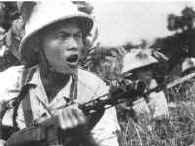 |
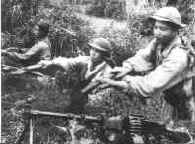 |
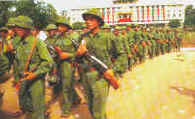 |
| NVA Platoon
Leader |
NVA Machine
Gun Team |
NVA in
Saigon at war's end |
| They called him Charlie or
Victor Charles (from VC) or the nogs, or noggies or The Cong (from Viet
Cong).
But whatever they called him they respected his fighting ability
and his ability to fight a war with very little in the way of equipment.
They fought him, mostly they beat him but in the most political war ever
fought his strongest weapon, the TV sets in American homes, proved
unbeatable.
The USA, having originally decided not fight the war to win
then decided to withdraw so Australia did also.
The
Viet Cong (called VC) were an irregular force of peasants, farmers and the
like who blended into the surroundings because they lived there. They were
hard (impossible?) to pick unless they were actually engaged in warlike
activity at the time.
They were a tough ruthless enemy who
were not afraid to use any means at all, including their women and children, to
further their aims.
After the American (therefore all
allied) troops withdrew the end was inevitable for the South Vietnamese forces who
had no heart for the war.
|
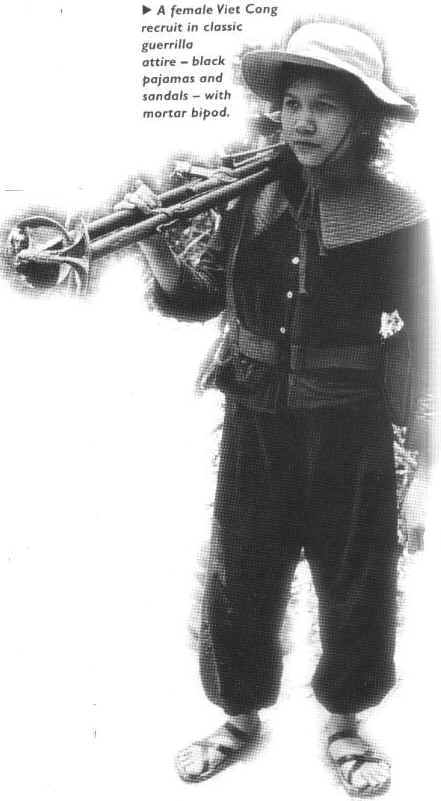 |
| It used to be said that weapons of the Army of
the Republic of Viet Nam (ARVN) were good value on the second hand market
as they were "never fired and
only dropped once".
Victor Charles eventually
won. Mostly he was dead, wiped out in the Tet Offensive that was a
military disaster for them, but a political gold-mine. |
 |
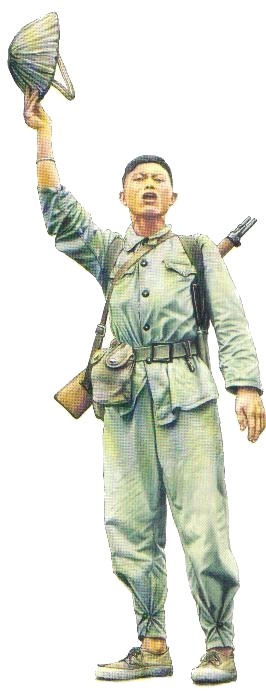 |
|
NVA (above right)
This bloke is a
North Vietnamese Army (NVA) regular soldier. Reasonably well trained,
better equipped than the Viet Cong guerrillas and more likely to be
in large numbers. The NVA relied heavily on China and Russia for arms, equipment
and money but they fought their own war.
It was they that continued the battle
after the Viet Cong were destroyed as a fighting force in the Tet
Offensive where they lost 30,000 troops but changed the mind of Walter
Cronkite, premier American TV newsreader, as to who was winning the war. President
Johnson said "If I've lost Walter Cronkite I've lost Mr Average
Citizen".
After the war an American colonel said
to a North Vietnamese colonel "You
know, you never defeated us on the battlefield".
The reply was "That may be so
. . . but it is also irrelevant". |
|
ORGANISATION OF NVA &
VC UNITS |
|
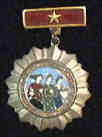 The
organisation detailed below is, in effect, a
VC Main Force Company,
although you could take elements of this organisation for Regional
forces. Local forces were not organised to this level, being an
assortment of combatants and arms. The
organisation detailed below is, in effect, a
VC Main Force Company,
although you could take elements of this organisation for Regional
forces. Local forces were not organised to this level, being an
assortment of combatants and arms.
Similarly, other than Main Force
units, the weapons
carried by Regional and Local forces would be an incredible
assortment of old and relatively new. A lot of SKS carbines, old
WWII vintage rifles, SMG's etc. Very few AK-47's would be evident,
even in Main Force units until later in the war.
One very important point to remember
when researching these units (and regular NVA) is the critically short
amount of ammunition available. Every bit had to come down
the Ho Chi Minh Trail.
Also remember that, following the Tet
offensive of February 1968, the VC virtually ceased to exist as a
coherent fighting force, having been almost destroyed in depth by
the allies. Engagements with VC units after this date involved
confronting substantial numbers of regular NVA
cadre troops within the ranks of the VC and a commensurate
increase in the quality of weaponry and support fire!
|
 VC
Local Guerrillas VC
Local Guerrillas
These were the archetypal 'farmers by
day, soldiers by night', comprising those either too old or too
young to fight in the regular VC units and dressed as local
peasant farmers.
Whilst their primary activities
consisted of intelligence gathering, sniping and emplacing booby
traps, these troops were employed in the support of VC
Regional and Main Force units operating in their locality as
porters, scouts and guides.
Force size was dependent on the size
of the local village or hamlet and ranged from a single 3 man cell
to a platoon of 3-4 squads. Generally operated at the squad level
of 12 men.
|
|
VC
Regional Guerrillas
The Regional
units of the Vietcong more often than not operated as independent
companies but often split up and dispersed into platoons, squads
and cells. These soldiers were full-timers and were better
equipped and trained than the local guerrillas. The personnel of
these units were often local to the area in which they served.
Generally these units
operated within their home region and fought as fully formed
units.
|
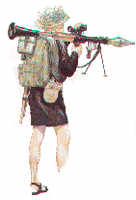
|
NVA Main-force
Regulars
Known as 'hard hats'
since they wore the ubiquitous pith helmet, these forces operated
and were organised along traditional military lines. Organised
into battalions consisting of 3 Rifle Company's and a Combat
Support Company these troops were, on the whole, well trained,
aggressive and well led.
On larger operations
they could be organised and deployed as regiments of 2-3
battalions.
|
ORGANISING
A VIET CONG INFANTRY COMPANY
| COMPOSITION
OF COMPANY |
|
| |
1 x Company
HQ Section |
|
| |
3 x Rifle
Platoons (each 1 x Platoon
HQ Section, 4 x Rifle
Squad) |
| |
Combat
Support Elements (Attached) |
|
| Company
HQ Section |
|
| |
1 x Captain |
|
|
| |
1 x Lieutenant |
|
|
| |
1 x RTO |
|
|
| |
2 x Runner |
|
|
|

|
|
| Rifle
Platoon HQ Section |
|
| |
1 x Lieutenant |
|
|
| |
1 x Senior Sergeant |
|
|
| |
1 x Runner |
|
|
|

|
|
| Rifle
Squad |
|
| |
1 x Sergeant |
|
|
| |
1 x Corporal |
|
|
| |
1 x RPD 7.62mm
MG |
|
| |
6 x Riflemen |
|
|
|

|
|
| Combat
Support |
|
| |
1 x Sergeant |
|
|
| |
2 x Corporal |
|
|
| |
1 x .30 Cal MG
(3 crew) |
|
| |
1 x 60mm Mortar
(3 crew) |
|
| |
1 x 57mm RR (3
crew) |
|
| |
3 x Riflemen |
|
|
|

|
|
| NOTES |
| Most accounts of
engagements with the VC mention almost prolific use of RPG', in
particular the RPG-2 and RPG-7.
The attached Combat Support Elements
of the Company are not fixed, unlike the Weapons squads of the US
Rifle Platoon and are very versatile. All VC operations were
carefully planned and executed and invariably involved
considerable supporting fire for the Rifle Company's involved.
Main Force units would often be supported by Weapons Platoons
consisting of heavier weapons such as 12.7mm AAMG's, 81/82mm
Mortars and larger calibre Recoilless Rifles (normally 75mm).
|
|
|
|
HIGHER
FORMATIONS
|
|
|
| BATTALION:
Battalion HQ, Political Staff, 3 x Rifle Company, 1 x Combat
Support Company, 1 x Signal Platoon, 1 x Recon Platoon, 1 x Sapper
Platoon. As in other armies, battalions were organised into
Brigades, Regiments and Divisions. The nature of the war however,
with overwhelming US Artillery and Air power, precluded the
fielding of large formations for any period of time longer than
was necessary to carry out a particular mission. As a result units
were dispersed quite widely, either in the sanctuaries of Laos and
Cambodia or in Base
Camps in very remote areas such as the A-Shau Valley.
This dispersal of units was one of the
main reasons that allied forces were unable to bring the enemy to
combat in significant numbers as predicated in the classic policy
of Search & Destroy and resulted in the numerous fire fight
engagements rather than pitched Divisional strength engagements.
|
|
|








 The
organisation detailed below is, in effect, a
VC Main Force Company,
although you could take elements of this organisation for Regional
forces. Local forces were not organised to this level, being an
assortment of combatants and arms.
The
organisation detailed below is, in effect, a
VC Main Force Company,
although you could take elements of this organisation for Regional
forces. Local forces were not organised to this level, being an
assortment of combatants and arms. VC
Local Guerrillas
VC
Local Guerrillas

